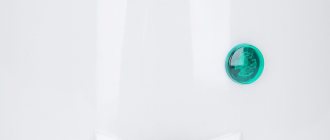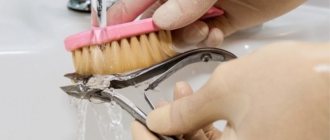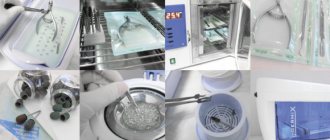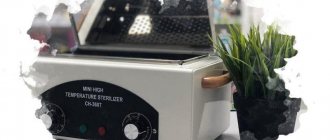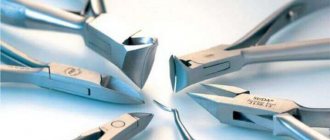Beauty salons involve a large number of clients coming for manicure treatments. This places considerable responsibility on their health. Otherwise, problems will arise that will cost much more.
As you know, manicure tools need a product with which they can be washed, disinfected and treated. A product such as Alaminol (a chlorine-free disinfectant with versatility) is ideal for this.
The active ingredients of Alaminol are glyoxal and alkyldimethylbenzylammonium chloride , which exhibit the activity of bacteria, Candida fungi, tuberculous mycobacteria, pathogens of acute respiratory infections, viral parenteral hepatitis, HIV infection, herpes, rota-, entero-, and polioviruses.
What is disinfection of manicure instruments?
The stage of removing nail dust and pathogenic microbes is called disinfection of manicure equipment. The procedure is typical for such reusable tools as scissors, files, and wire cutters. It consists of soaking in a special diluted disinfectant composition for 1 hour.
For these purposes, Brilliant, MultiDez, Alaminol, Optimax and other disinfectant compounds are used. Liquid diluted with water is poured into a special container, and then the equipment is lowered into it. At the end of the procedure, the manicure instrument is thoroughly rinsed with running water, and then dried in air and sterilized.
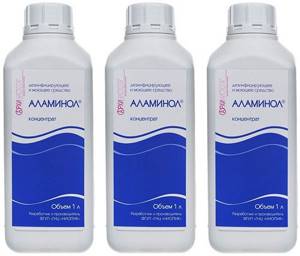
Alaminol for manicure tools
According to sanitary rules, disinfection should be carried out after each client with an entry in the log book. It is possible to disinfect your own set of tools at home: to do this, it will be enough to leave it for 30 minutes. in ethyl alcohol, and then in an oven at temperatures up to 250 ℃.
The difference between disinfection and sterilization is as follows:
- performed directly while using protective equipment in the form of masks, goggles and gloves;
- applies not only to the manicure table, but also to the device’s attachments, equipment, baths, polymerizing lamps, chairs, couches and other tools;
- using concentrates of liquid consistency without the use of technology;
- removes major microbes.

This process is preliminary, after which sterilization occurs, thanks to which you can get rid of spores, fungi, viruses and bacteria.
Standards according to SanPiN
The following list shows the norms of procedure according to SanPiN:
- The purpose of this procedure is to remove pathogenic microorganisms and prevent their proliferation on the surface of the working tool.
- Before performing any procedure, the master must wash his hands with soap and then treat them with an antiseptic.
- The baths are disinfected by immersing them in a disinfectant composition.
- When performing disinfection, it is necessary to use solutions that will not harm health. Compositions with hazard classes 1 and 2 are prohibited.
- General cleaning of the work area must be carried out using disinfectant compounds, followed by wiping the walls, baseboards, windows, flooring and doors.
- Disinfection of the surface of furniture and equipment should be performed up to 2 times during the day.
- Disinfection is carried out after people stop visiting, and it will need to be carried out in a place specially designated for this purpose.
- The disinfection liquid must be stored in a hermetically sealed container, which is marked with the date of manufacture, name and shelf life.
- Equipment made of metal is disinfected by completely immersing it in the disinfection composition for a period of 30 to 60 minutes.
- On the container in which the treatment is carried out, it is necessary to put an inscription about its purpose, as well as the concentration of the solution. The container must be provided with an airtight lid.
- The instrument is processed by immersing it in a disinfectant solution.
- Hand rests and oilcloth pillows are also treated with a disinfectant solution after each client.
- Treatment is carried out in case of possible viral hepatitis.
- Hand wipes should only be disposable and do not get wet. They must be disposed of after each use.
Procedure time
To disinfect working manicure tools, the procedure should continue for 60 minutes. Also, the time period allotted for processing equipment directly depends on the concentration of diluted Alaminol.
Description of the product
Everyone involved in nail services should know how to dilute Alaminol to disinfect manicure instruments. It is an antiseptic and appears as a blue liquid with a rich odor. Sold in 1 and 3 liter packages.
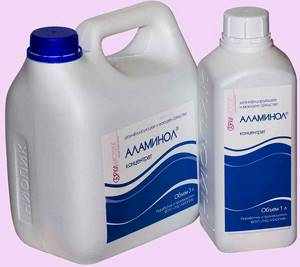
The active ingredients of the product are benzalkonium chloride and glyoxal. The concentrated drug must be diluted with water.
Alaminol is used to process the following things:
- underwear;
- massage equipment;
- processing of beauty salons and hairdressing salons;
- catering establishments;
- medical working surfaces;
- equipment intended for dental procedures;
- cleaning equipment;
- surgical instruments.
The product is used in the fight against fungal mold and for cleaning areas at municipal facilities. The main advantage of the composition is that it is almost safe in contact with an open area of skin and mucous membranes.
Properties
Manicure service specialists will tell you how to dilute Alaminol to disinfect manicure instruments. They recommend strictly following the instructions given on the package. Due to this, you can properly dilute the concentrate, obtaining a safe solution for processing equipment.
The drug contains substances that can have a negative effect on pathogenic bacteria and viruses. It is characterized by a tuberculocidal effect. Manufacturers of the concentrate note that it has fungicidal and detergent properties.
Despite the fact that the composition is characterized by a rich odor, it does not irritate the mucous membranes. The liquid may be greenish or bluish in color. After dilution, the composition smells like a cosmetic fragrance.
Since the concentrate has a fairly wide range of effects, it is used in beauty salons, manicure salons, medical institutions and catering establishments. When processing equipment, the risk of possible infection of people with pathogenic microbes is reduced.
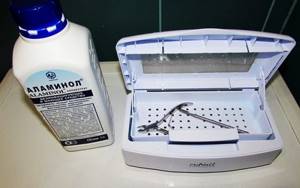
Alaminol is suitable for both disinfecting instruments and treating work surfaces. The procedure makes it possible to protect objects from the development of fungal mold.
Benefits of use
The use of Alaminol has the following advantages:
- without much difficulty it will help rid the instrument of viruses, bacteria, and fungal infections;
- its use is allowed in medicine because it has a fast-acting effect;
- the prepared solution is usually stored for up to 10 days or until the liquid begins to darken;
- the vapors of the composition do not cause any harm to health, and in case of contact with the skin, it will be enough to wash your hands with soap and plenty of water;
- does not have a fixing effect, the drug can be used a large number of times;
- despite the fact that alaminol has an aggressive reaction to chemicals, it is gentle on metal;
- when storing the concentrate in a darkened room in a glass bottle made of thick glass, the bactericidal properties of the drug can last for up to 1 year;
- is affordable.
Stages of the sterilization process: the correct order
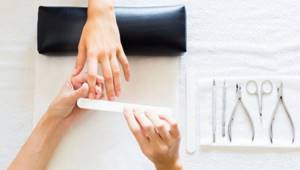
According to SanPiN standards, all cutting and rotating instruments used when performing manicures or pedicures must undergo a full sterilization cycle.
All sterilization consists of the following steps:
- Disinfection;
- Pre-sterilization cleaning - PSO;
- Drying;
- Sterilization;
- Storage.
Drying and storage are intermediate, but very important stages for following the complete technology. The main ones are disinfection, PSO and sterilization. If we break the order, we will end up with unsanitary conditions.
Side effects of the solution
How to dilute Alaminol to disinfect manicure instruments is indicated in the manufacturer's instructions.
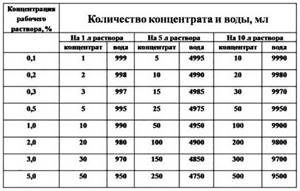
If the rules for diluting the concentrate are not followed, side effects may occur, in which case you will need to perform the following actions:
- If the product gets on the skin, irritation may occur, accompanied by redness. It is recommended to rinse the lesion with plenty of water and then treat it with an emollient baby cream.
- If the drug penetrates the eyeball, the eyes should be rinsed very quickly with warm water, and then a couple of drops of sodium sulfacyl should be instilled.
- Getting a disinfectant inside is dangerous. If this happens, you will urgently need to take from 10 to 20 tablets of activated carbon, washed down with up to 500 ml of water.
Features of the PSO stage - pre-sterilization cleaning
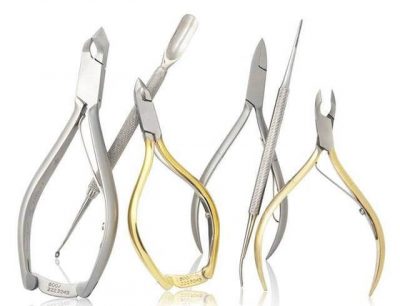
Pre-sterilization cleaning consists of two stages:
- The first is to clean the manicure tool from dirt directly in the disinfection solution. This is done with a brush, cotton pad or rag. Not every solution is suitable for this, so when purchasing a disinfectant, you must look at the “Disinfection combined with PSO” criterion.
- Second stage – Rinse the instrument in running water. This is done in order to wash away the remnants of the solution itself, which spoil the instrument during further sterilization at high temperature.
The instructions for the solution indicate whether it is suitable for disinfection and PSO. If this data is not available, then for the first stage of pre-sterilization cleaning it is necessary to prepare another solution. Often, the same disinfectant can be used for this, only in a different proportion. It's simply inconvenient.
Look for a table in the instructions for the drug that indicates the possibility of combining disinfection with PSO, and buy only such options.
Instructions for use
Luxury beauty salons receive a large number of clients, which place enormous responsibility on the staff and owners. Such an establishment must provide services that will not expose the client to the risk of infection when carrying out any procedures through poorly processed equipment and tools.
Due to irresponsibility, problems may arise that will cost much more than the treatment of rooms, inventory and equipment. Below you can find out how to properly dilute the concentrate composition for the procedure and how to use it.
How to properly dilute for disinfection
Nail service specialists know how to dilute Alaminol to disinfect manicure instruments. They recommend making the composition by diluting the antiseptic concentrate with plain water. Due to different purposes, different amounts of Alaminol are needed per 1 liter of the drug.
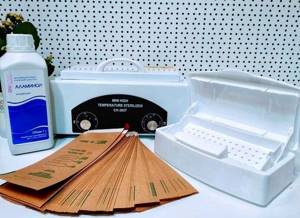
The drug is used in the following concentrations: 1, 1.5, 3, 5, 8 and 10%. Before diluting the composition, it will be useful to know that salons use solutions of 5% and 8%, and the disinfected equipment is kept in a hermetically sealed container.
The correct proportions of water and concentrate are given in the following table:
| Composition concentration, % | Alaminol volume, ml | Water volume, ml |
| 1 | 10 | 990 |
| 1,5 | 15 | 985 |
| 3 | 30 | 970 |
| 5 | 50 | 950 |
| 8 | 80 | 920 |
| 10 | 100 | 900 |
If the solution remains, it can be stored for no more than 10 days or until a cloudy color appears. If these signs are detected, further use of the disinfection solution is prohibited.
Regarding concentration, solutions are used as follows:
- 1 – 1.5%: light disinfection is carried out by wiping the working surface. The composition is not able to overcome tuberculosis, but it will help get rid of mild bacteria.
- 3 – 5%: destroys viruses with tuberculosis.
- 8 – 10%: A concentrated formulation that can fight fungal infections.
How to use
Manicure equipment is disinfected manually in enamel containers, as well as in plastic trays with lockable lids. The working medium must have a temperature of at least 18 °C.
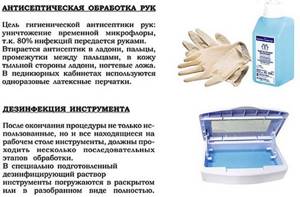
The method of using the concentrated composition is described in the following paragraphs:
- The product must be completely immersed in the prepared disinfectant.
- Empty cavities and channels must be filled with liquid, while avoiding the appearance of air pockets.
- Equipment with locking parts must be opened so that the disinfectant composition can better penetrate hard-to-reach areas.
- A tool that can be disassembled is recommended to be processed in parts.
- The thickness of the layer of treatment agent over the processed products must be at least 1 cm.
- It is recommended to treat the tool immediately after use.
- Wipes that have been used must be immediately placed in a container with a disinfectant.
- When the time required for processing is over, you will need to remove it and then rinse thoroughly under running water for 5 minutes.
Special disinfectants for cutters
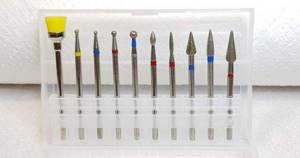
These are ready-made solutions that retain the characteristics of cutters for a longer time. They are quite expensive considering the consumption, so their use cannot be called economical in the work of a master. There are special small baths for disinfection for cutters. Each time it is necessary to use such an amount of product so that it covers the cutters 1 cm above.
Popular brands of disinfectants for cutters:
- Clindesin;
- Deconex Dental BB;
- Rotasept;
- Antibor.
Milling cutters for the device: types, purpose, how to choose and use in manicure and pedicure
The next step after disinfection, pre-sterilization cleaning and drying is sterilization.
How and with what to disinfect, sterilize and clean manicure instruments
Precautionary measures
When working with concentrated liquid, it is imperative to adhere to safety precautions. The composition must not be taken orally. If this happens, you need to use activated carbon and drink plenty of fluids. The composition should not come into contact with the skin and mucous membranes, as it can cause redness and irritation.
In this case, it is recommended to rinse off the product with water and soak the skin with moisturizer. If the drug gets into your eyes, you will need to rinse them under running water and then treat them with 2 drops of sodium sulfacyl.
Since the liquid is suitable for processing manicure tools, it is advisable to use a 5% or 8% solution. Be sure to follow the instructions on the packaging. This is explained by the fact that for any chemical sterilizing drug it will be different.

Before diluting the concentrate, your hands should be protected with rubber gloves. When immersing a manicure tool in a disinfectant solution, it is recommended to use a container with a sealed lid.
If the rules for using the solution are violated, corrosion may appear on the metal surface. As a result, you will need to buy a new tool. The disinfectant should be stored separately from other medical compounds.
Composition and release form
The drug Alaminol has a multicomponent composition that allows it to actively fight pathogenic microflora. The active ingredients are glyoxal (8%) and alkyldimethylbenzylammonium (5%).
Additional components are:
- water;
- Surfactants that provide a cleaning effect;
- fragrances for a pleasant smell;
- dyes.
Alaminol is available in the form of a clear, concentrated blue liquid that has a slight odor and is highly soluble in water.
Instructions for use of Alaminol contain important information about the safety of the drug, in particular about its toxicity classes:
- if it enters the digestive canal, it exhibits moderate toxicity (class 3);
- upon contact with skin, they have a negligible effect (class 4).
Despite the low toxicity, when preparing medicinal solutions based on Alaminol and their use, caution is required, as well as compliance with certain rules, among the main ones:
- work with disinfectants while protecting your hands with gloves;
- always close containers with disinfectant, whether it is a concentrate or a working solution;
- Avoid contact of the drug with the mucous membranes of the nose, mouth and eyes.
The disinfectant is poured into plastic containers (bottles or canisters) with a volume of 1, 3, 5 (l).
Analogs
Instead of Alaminol, you can use its analogues, which are used for processing manicure equipment:
- Anolyte is neutral. The liquid is colorless or transparent and has a chlorine odor. The composition copes well with the destruction of bacteria, viruses, and is also characterized by an anti-mold effect. It differs from Alaminol in that the finished solution can be used only once a day. If the composition remains, it needs to be poured out. The cost of the drug with a volume of 500 ml is approximately 245 rubles.
- Virkon. Presented in the form of a high quality powder, which must be diluted with distilled water. It copes well with various bacteria and viruses. It is also used in medical institutions for the purpose of processing furniture, equipment, instruments and premises. For dilution, a 1% or 2% solution is often used. When prepared, the drug is stored for 24 hours. The price for 350 g of powder reaches 279 rubles.
- Presept. Acts as granular tablets that need to be diluted with water. To do this, you will need to dissolve 1 tablet of 2.5 g in 2.5 liters of liquid. The diluted product can be stored in a hermetically sealed container for 5 days. The composition has a wide spectrum of effects, therefore it is suitable for eliminating various infections (for example, hepatitis B). The cost of the product reaches 1,385 rubles.
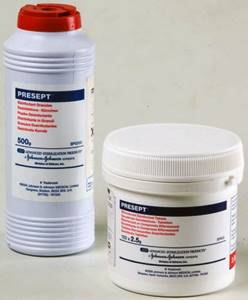
Similar compositions are inferior in properties to Alaminol. Therefore, the latter is considered the market leader.
Alaminol is used to maintain cleanliness and disinfection of manicure instruments. To do this, the composition is diluted in the required amount of water. Processing of instruments is required to ensure that no contamination occurs during the procedure.
